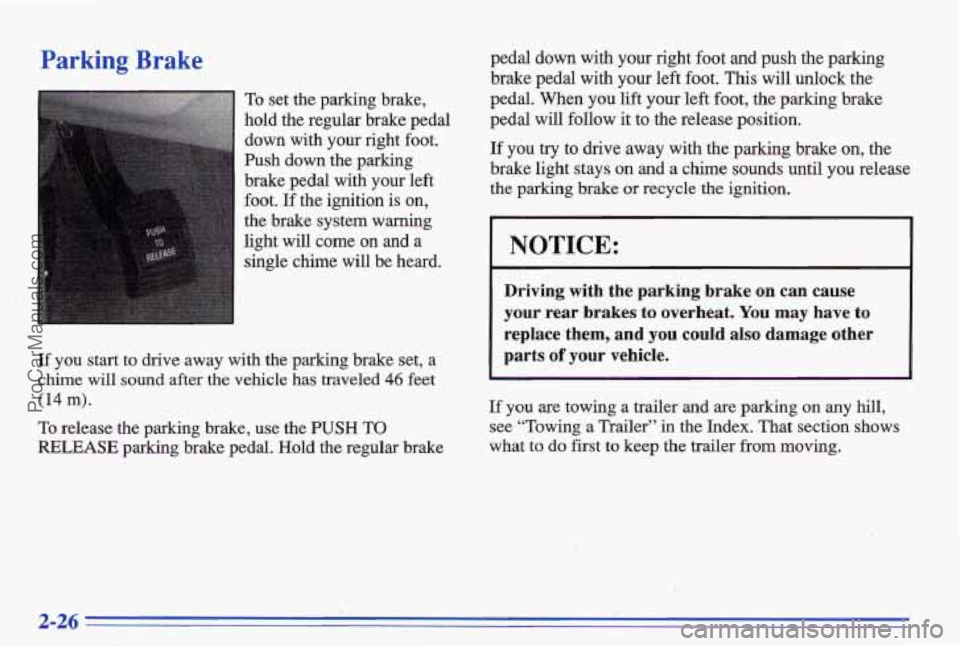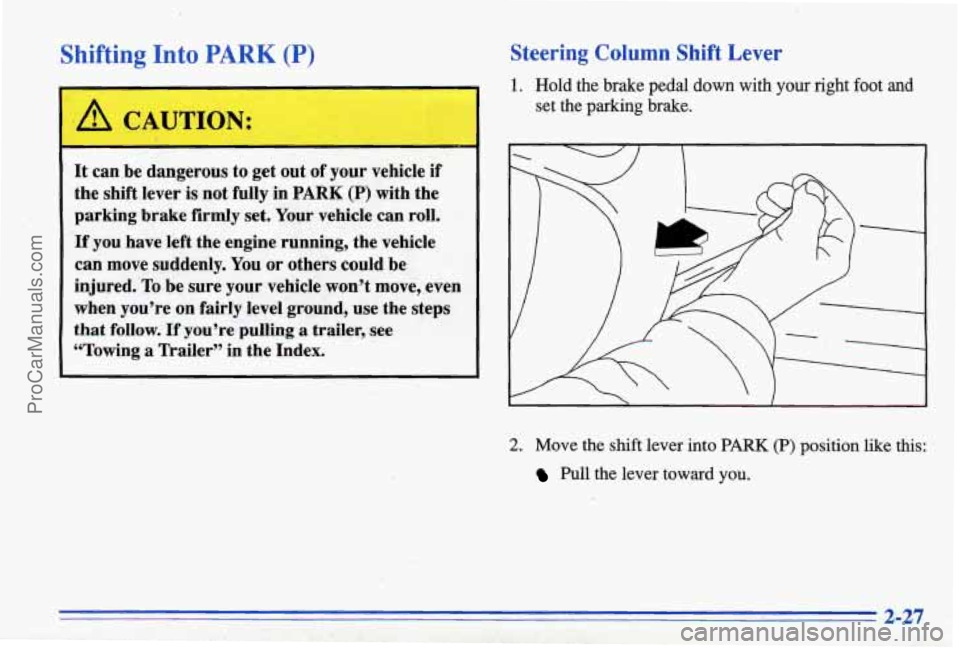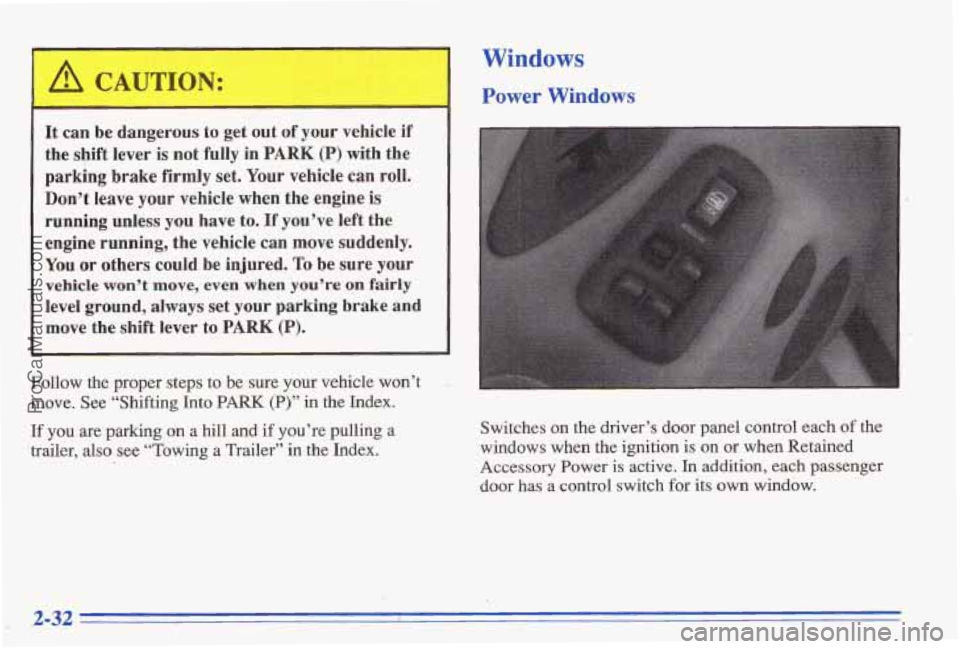1996 PONTIAC BONNEVILLE towing
[x] Cancel search: towingPage 67 of 387

See your Pontiac dealer or a locksmith who can service
the PASS-Key
IT to have a new key made.
If you’re ever driving- and the SECURITY light comes
on and remains on, you will be able.to restart your
engine
if you turn it off. Your PASS-Key 11 system,
however, is
not working properly and must be serviced
by your Pontiac dealer.
Your vehicle is not protected by
If you lose or damage a PASS-Key II ignition key, see
your Pontiac dealer
OT a locksmith who can service
PASS-Key 11 to have a new key made. In an emergency,
call the Pontiac Roadside Assistance Program
at
1-800-ROADSID3, or 1-800-762-3743.
. the PASS-Key II system.
New Vehicle (LBreak-In99
NOTICE:
P
Your modern Pontiac doesn’t need an elaborate
“break=in?’.But
it win perform better in the long
run if you follow these guidelines:
Dm’t drive at any one speed. -- fast or
slow
-- for the first 500 miles (804 km).
Don’t make full-throttle starts.
200 miles (322 km) or so. During this time
your new brake linings aren’t yet broken
in. Hard stops with new linings
can mean
premature wear
and earlier replacement.
Follow
this breaking-in- guideline every
time youmget new brake linings.
See ‘cTowing
a flrailer” in the Index for
more information.
Avoid making hard. stops for the first
Don’t tow a trailer during break-in.
2-16
ProCarManuals.com
Page 70 of 387

Starting Your 3.8 Liter Engine
1. Without pushing the accelerator pedal, turn your
ignition key to
START. When the engine starts, let
go of the key. The idle speed will go down as your
engine gets warm.
.
NOTICE:
Holding your key in START for longer than
15 seconds at a time will cause your battery to be
drained much sooner. And the excessive heat can
damage your starter motor.
2. I€ it doesn’t start right away, hold your key in
START for about three to five seconds at a time until
your engine
starts. Wait about 15 seconds between
each
try to help avoid draining your battery.
3. If your engine still won’t start (or starts but then
stops), it could
be flooded with too much gasoline.
Try pushing your accelerator pedal all the way to the
floor and holding it there as you hold the key in
START for about three seconds. If the vehicle starts
briefly but then stops again, do the same thing, but
this time keep the pedal down for five or
six seconds.
This clears the extra gasoline from the engine.
After waiting about 15 seconds, repeat the nomd
starting procedure.
NOTICE:
I
Your engine is designed to work with the
electronics in your y,ehicle.
If you add electrical
parts or accessories, you could change the way
the engine operates. Before
adding electrical
equipment, check with your dealer.
If you don’t,
your engine might not perform properly.
If you ever have to have your vehicle towed, see
the part of this manual that tells how to do it
without damaging your vehicle. See “Towing
Your Vehicle”
m the Index.
ProCarManuals.com
Page 72 of 387

Automatic Transaxle Operation
Your automatic transaxle may have a shift lever
located on the console between the seats or on the
steering column.
There are several different positions for your shift lever.
PARK (P): This locks your front wheels. It’s the best
position to use when you start your engine because your
vehicle
can’t move easily. It
is dangerous to get out of your vehicle if the
shift lever
is not fully in PARK (P). with the
parking brake firmly set. Your vehicle can roll.
Don’t leave your vehicle when the engine
is
running unless you have to. If you have left the
engine running, the vehicle can move suddenly.
You or others could be injured.
To be sure your
vehicle won’t move, even when you’re
on fairly
level ground, always set your parking brake and
move the
shift lever to PARK (P).
See “Shifting Into PARK (P)” in the Index. If
you’re pulling
a trailer, see “Towing a Trailer” in
the Index.
2-21
ProCarManuals.com
Page 74 of 387

NOTICE:
Damage to your transaxle caused by shifting out
of
PARK (P) or NEUTRAL (N) with the engine
racing isn’t covered by your warranty.
AUTOMATIC OVERDRIVE
(D): This position is for
normal driving. If you need more power for passing,
and you’re:
- Going less than about 35 mph (56 km/h), push your
- Going about 35 mph (56 h/h) or more, push the
You’ll shift down to the next gear and have more power.
accelerator pedal about halfway down.
accelerator
all the way down.
NOTICE:
If your vehicle seems to start up rather slowly, or
if it seems not to shift gears as you
go faster,
something may be wrong with
a transaxle system
sensor.
If you drive very far that way, your
vehicle can be damaged.
So, if this happens, have
your, vehicle serviced right away. Until then,
you
can use SECOND (2) when you are driving less
than
35 mph (56 kdh) and AUTOMATIC
OVERDRIVE
(0) for higher speeds.
DRIVE (D): This position
is also used for normal
driving, however, it offers more power
and lower fuel
economy than AUTOMATIC
OVERDRIVE (@).
Here are some times you might choose DRIVE (D)
instead of AUTOMATIC OVERDRIVE (@):
- When driving on hilly, winding roads
- When towing a trailer, so there is less shifting
between gears
- When going down a steep hill
ProCarManuals.com
Page 77 of 387

Parking Brake
To set the parking brake,
hold the regular brake pedal down- with
your right foot.
Push down the
parking
brake pedal with your left .
foot. If the ignition is on,
the brake system warning
light will come on
and a
single
chime will be heard.
If you start to drive away with the parking brake set, a
chime will sound after the vehicle has traveled 46 feet
(14
m).
To release the parking brake, use the PUSH TO
RELEASE parking brake pedal. Hold the regular brake pedal down with
your right foot and push the parking
brake pedal with your left foot. This will unlock the
pedal. When you lift your left foot, the parking brake
pedal will
follow it to the release position.
If you try to drive away with the parlung brake on, the
brake light stays
on and a chime sounds until you release
the parking brake or recycle^ the ignition.
I
NOTICE:
Driving with the parking brake on can cause
your rear brakes to overheat.
You may have to
replace them, and you could also damage other
parts
of your vehicle.
If you are towing a trailer and are parking on any hill,
see “Towing a Trailer” in the Index. That section shows
what
to do first to keep the trailer from moving.
2-26
ProCarManuals.com
Page 78 of 387

Shifting Into PARK (P)
I
It can be dangerous to get out of your vehicle if
the shift lever is not fully
in PARK (P) with the
parking brake firmly set. Your vehicle can roll.
If you have left the engine running, the vehicle
can move suddenly.
You or others could be
injured.
To be sure your vehicle won’t move, even
when you’re on fairly level ground, use the steps
that follow.
If you’re pulling a trailer, see
“Towing
a Trailer” in the Index.
Steering Column Shift Lever
1. Hold the brake pedal down with your right foot and
set the parking brake.
2. Move the shift lever into PARK (P) position like this:
Pdl the lever toward you.
ProCarManuals.com
Page 83 of 387

It can be dangerous to get out of your vehicle if
the
shift lever is not fully in PARK (P) with the
parking brake
firmly set. Your vehicle can roll.
Don’t leave your vehicle when the engine
is
running unless you have to. If you’ve left the
engine running, the vehicle can move suddenly.
You or others could be injured.
To be sure your
vehicle won’t move, even when you’re an fairly
level ground, always set your parking brake and
move the
shift lever to PARK (P).
Follow the proper steps to be sure your vehicle won’t
move. See “Shifting
Into PARK (P)” in the Index.
If you are parking on a hill and if you’re pulling a
trailer, also see “Towing a Trailer” in the Index.
Windows
Power Windows
Switches on the driver’s door panel control each of the
windows when the ignition is
on or when Retained
Accessory
Power is active. In addition, each passenger
door has a control switch for its own window.
ProCarManuals.com
Page 116 of 387

Brake System Warning Light
If the warning light comes on, there could be a brake
problem. Have
your brake system inspected right away.
,BRAKE (a)
This light should come on
when
you turn the ignition
key to START.
If it doesn’t
come on then, have it fixed
so it will be ready to warn
you
if there’s a problem.
If the light and chime come on while you are driving,
pull
off the road and stop carefully. You may notice that
the pedal
is harder to push. Or, the pedal may go closer
to the floor.
It may take longer to stop. If the light is still
on, have the vehicle towed for service. (See “Towing
You Vehicle” in the Index.)
A CAUTION:
Your brake system may not be working properly
if the brake system warning light is on. Driving
with the brake system warning light on can lead
to an accident. If the light
is still on after you’ve
pulled
off the road and stopped carefully, have
the vehicle towed for service.
When the ignition is on, the brake system warning light
will also come on when you set your parking brake. The
light will stay on if your parking brike doesn’t release
fully. If you try to drive off with the parking brake set,
a chime will also come on until you release the parking
brake.
If the light and chime stay on after your
parking brake is fully released,
it means you have a
brake problem.
ProCarManuals.com